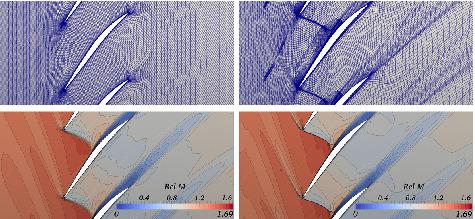当前位置:
X-MOL 学术
›
Int. J. Numer. Methods Fluids
›
论文详情
Our official English website, www.x-mol.net, welcomes your
feedback! (Note: you will need to create a separate account there.)
Sequential feature‐based mesh movement and adjoint error‐based mesh refinement
International Journal for Numerical Methods in Fluids ( IF 1.7 ) Pub Date : 2020-06-19 , DOI: 10.1002/fld.4882 Guglielmo Vivarelli 1 , Ning Qin 1 , Shahrokh Shahpar 2 , David Radford 3
International Journal for Numerical Methods in Fluids ( IF 1.7 ) Pub Date : 2020-06-19 , DOI: 10.1002/fld.4882 Guglielmo Vivarelli 1 , Ning Qin 1 , Shahrokh Shahpar 2 , David Radford 3
Affiliation

|
Nowadays, aerodynamic computational modeling is carried out on a daily basis in an industrial setting. This is done with the aim of predicting the performance and flow characteristics of new components. However, limited resources in terms of time and hardware force the engineer to employ relatively coarse computational grids, thus achieving results with variable degree of inaccuracy. In this article, a novel combination of feature and adjoint‐based mesh adaptation methods is investigated and applied to typical three‐dimensional turbomachinery cases, such as compressor and fan blades. The proposed process starts by employing feature‐based mesh movement to improve the global flow solution and then adjoint refinement to tune the mesh for each quantity of interest. Comparison of this process with one utilizing only the adjoint refinement procedure shows significant benefits in terms of accuracy of the performance quantity.
中文翻译:

基于特征的顺序网格运动和基于伴随误差的网格细化
如今,每天在工业环境中进行空气动力学计算建模。这样做是为了预测新组件的性能和流动特性。但是,在时间和硬件方面有限的资源迫使工程师采用相对粗略的计算网格,从而以可变程度的不准确性获得了结果。在本文中,研究了特征和基于伴随的网格自适应方法的新颖组合,并将其应用于典型的三维涡轮机壳体,例如压缩机和风扇叶片。拟议的过程首先采用基于特征的网格运动来改善整体流动解决方案,然后进行伴随的细化以针对每个感兴趣的数量调整网格。
更新日期:2020-06-19
中文翻译:

基于特征的顺序网格运动和基于伴随误差的网格细化
如今,每天在工业环境中进行空气动力学计算建模。这样做是为了预测新组件的性能和流动特性。但是,在时间和硬件方面有限的资源迫使工程师采用相对粗略的计算网格,从而以可变程度的不准确性获得了结果。在本文中,研究了特征和基于伴随的网格自适应方法的新颖组合,并将其应用于典型的三维涡轮机壳体,例如压缩机和风扇叶片。拟议的过程首先采用基于特征的网格运动来改善整体流动解决方案,然后进行伴随的细化以针对每个感兴趣的数量调整网格。











































 京公网安备 11010802027423号
京公网安备 11010802027423号